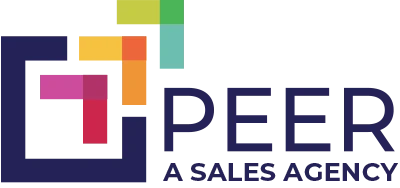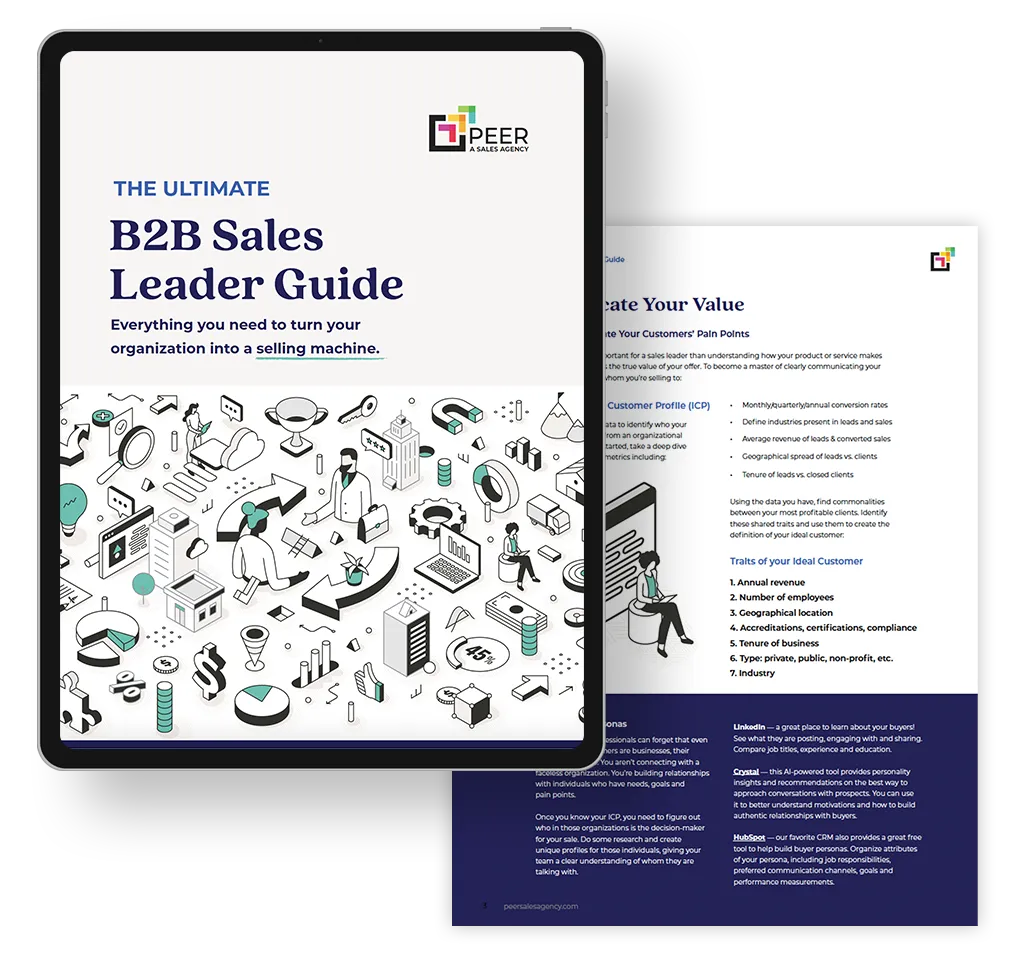Content marketing, organic SEO, B2B social media, and sales enablement are all long-term strategies for successful revenue growth. The key word here is “long-term” because these tactics can take 6 months to a year to produce real fruit, on their own. These low-cost, long-term strategies are great for organizations that are still crafting an internal sales process or who need to sales-optimize their website – but what about businesses with a sales team & a website that’s ready and raring to go?
That’s when it’s time to pour on the gas and get a paid digital marketing campaign planned.
What Business Goal Is This Campaign Supporting?
Paid digital ads should always be supporting a clearly defined business goal. Start by understanding your company’s overarching goals. These goals can look like:
- 4 new logos in six months
- 100,000 in new MRR by next year
- 25% more customers by 2030
Depending on your progress toward these goals and the timeline you set to achieve them, you’ll need to invest in tactics that drive brand awareness, generate leads, drive sales, or promote a specific product or service.
Always start with the overarching business goal before digging down into the campaign goal. Once you have the business goal, you’ll need to do some reverse engineering to determine which campaign goals will help you get there.
For example, if your goal is to land four new logos by Q2, you’ll need to take these steps:
- Look at your closed won vs total deals opened percentage for the last year. How many total deals will you need to open to win four more on your goal timeline?
- Take a look at your conversion rates from MQL to SQL and SQL to Deal. What percentage of MQLs become SQLs? What percentage of SQLs become Deals?
- If you got 100 MQLs last year, and 25 became SQLs, you have a 25% conversion rate at that stage.
- If 12 of those 25 SQLs became Deals, your conversion rate is about 50% at that stage.
- If 4 of those Deals went to Closed Won, you have a 25% win rate.
Using those numbers, you can identify that you’ll need to craft a campaign that lands 100 new MQLs.
You’ll also need to consider your sales cycle. If your goal is to land those four new logos in six months and your sales cycle is about 90 days, you’ll need to make sure your campaign captures all 100 MQLs in about 75 days. This “need for speed” will impact your budget almost more than any other factor.
What’s the Campaign’s Main Goal?
Once you’ve identified the business goal and reverse-engineered your sales numbers to figure out how many MQLs you need to capture, it’s time to set a campaign goal.
It’s always best to have a single campaign goal or conversion action in mind. This focused approach ensures that all efforts are directed toward achieving a specific outcome rather than scattering resources and diluting the campaign’s overall effectiveness.
For most B2B companies, revenue is rarely captured right away on a digital campaign. B2B sales are less transactional and more relationship-based. Don’t focus on getting a new customer right out of the gate; instead, focus on getting your prospect to take the next action that moves them down the funnel. In a paid digital campaign, that looks like:
- Convert a Stranger to a Visitor: Focus your campaign on increased website traffic. This can be achieved through various platforms, such as search engine advertising or social media marketing.
- Bring Visitors Back for More: Retargeting ads on social and display networks remind these visitors of your brand & website. Make sure you offer them something valuable or interesting to get them to opt in for communications at this stage!
- Convert Visitors to Opt-ins & Leads: By strategically targeting the right audience and crafting compelling ad content, you can attract and capture the contact information of potential customers who are interested in their products or services. By offering incentives or valuable content in exchange for email subscriptions or other forms of contact information, businesses can expand their reach and nurture relationships with a larger audience.
If you want to do all three of these things, you’ll need to craft a “full-funnel” digital marketing campaign that surrounds your prospect audience in messaging and offers that get them to check out your website and content, explore your brand on social media, take advantage of an offer in exchange for their contact information, and continuously nurture them with valuable information, guides, and social proof.
Our suggestion is to take it one step at a time and start at the funnel stage that makes sense for your business. If you already have a large list of marketing contacts who just need a little nudge to convert to the next stage, you don’t need to worry about building a list of opt-ins. Instead, your campaigns can start with an enticing middle-of-funnel offer like a free trial or discount pricing.
Scope Out the Competition
Now that you’ve got your campaign goals identified, you’ll want to take a beat and scope out the competition. With 90% of businesses saying that their industry has become more competitive in the last three years, you need to understand what your competitors are doing. This helps you identify which channels and tactics would be prohibitively expensive for your paid ad campaigns and which channels or tactics may represent an opportunity.
For example, if you’re considering paid search ads, most SEO software has a competitive research tool. For example, Semrush has a competitive research tool that allows you to see how much your competitors are spending on search ads. By analyzing their spending patterns and the keywords they’re bidding on, you can get an idea of their advertising strategy and make informed decisions for your own campaigns. For example, if a large enterprise competitor is spending $250K a month on the set of keywords you’re planning to spend $2,500 on… you’ll never win those bids.
Instead, take this opportunity to figure out what your niche keywords are. If they have a good search volume and your competitor isn’t bidding on them, this could be a good opportunity for you. However, if you have multiple enterprise competitors and your niche keywords aren’t getting great volume, you may determine that this channel isn’t right for what you’re able to spend.
Social ads are a great opportunity for most businesses to target only those users that fit their persona and ICP targets. Another simple way to research your competitors on LinkedIn is to make a quick stop by their company pages. These pages often showcase sponsored content and ads, giving you a glimpse into their social media advertising efforts.
No matter how you do your research, remember that you’re trying to identify gaps in the market and discover new opportunities for your brand.
What’s Your Offer?
If you want people to check out your content and give you their contact information, you need to give prospects something they want – something they can use to solve their own problems. Without a compelling offer, it is unlikely that a stranger will willingly provide their personal information or engage further with a business.
Depending on the funnel stage your campaign is targeting, these “offers” may look like:
- Compelling, interesting, educational blog content that convinces them to subscribe
- A handy comparison guide, toolkit, or checklist that they opt-in to receive by email
- A free trial of software for SaaS businesses
- A webinar or event they wish to attend to learn a skill or get a question answered
- A free sample of your product
- A discount on their purchase
Whatever your offer, be sure that it incentivizes your visitors to take the desired action. Businesses establish trust and build a connection with their audience by offering something that addresses a pain point or a solution. Don’t be afraid to offer something truly valuable.
Your Campaign Budget
Now that you know what your competition is spending and have figured out a great offer for your prospects, you’ll need to set a campaign budget.
In addition to the ad spend itself, there are other expenses to consider. These may include creating ads, landing pages, follow-up blog content, and lead-nurturing emails. You may have a time or software cost to ensure that all leads and intent signals are delivered to your sales team.
Your campaign budget and ad spend should be part of your greater marketing budget. Check out our detailed resource on setting your marketing budget here.
Choose the Right Channels to Support Your Goal
Selecting the right channels is crucial when it comes to getting the results you’re after with a paid digital campaign. By carefully considering your target audience, the nature of your message, and the strengths of various channels, you can make informed decisions and maximize your chances of achieving your goals. Let’s take a look at the three most common paid media channels and the single channel that’s most often forgotten:
Paid Search Ads
Paid search ads, also known as pay-per-click (PPC) ads, are online advertisements that businesses pay for when a user clicks on them. These ads appear at the top or bottom of search engine results pages, displaying relevant information about a product or service when users search for specific keywords. Paid search ads can also be displayed on various websites that participate in ad networks.
Paid search ads are particularly effective for campaigns that aim to generate leads or drive conversions. They allow businesses to target specific demographics and locations, ensuring that the ads reach the right audience.
However, it is worth noting that paid search ads can be more expensive compared to other marketing tactics. This is because they typically target users who are already in the middle of the funnel, meaning they are actively searching for a particular product or service. While this increases the likelihood of conversions, it also means that businesses will need to invest more in advertising costs.
Pros of using paid search ads include:
– Immediate visibility: Paid search ads appear at the top of search engine results, increasing visibility and driving targeted traffic to a website.
– Targeted audience: These ads can be tailored to reach a specific demographic and location, improving the chances of attracting potential customers.
– Measurable results: Paid search ads offer detailed analytics and insights, allowing businesses to track and measure the success of their campaigns.
Cons of using paid search ads include:
– Cost: As mentioned earlier, paid search ads can be more expensive compared to other tactics due to the higher targeting level and competition for keywords.
– Limited organic reach: While paid search ads provide immediate visibility, they do not have the long-term benefits of organic search results, which can continue to drive traffic even after the campaign ends.
Social Media Ads & the LinkedIn Display Ad Network
Social media ads have become an integral part of most paid strategies. They create targeted and engaging content that reaches a focused, persona-based audience. Specifically, on LinkedIn, these ads allow businesses to promote their products or services to professionals and decision-makers in various industries.
LinkedIn’s Display Ad network is a segment of its advertising platform that enables businesses to showcase their ads on LinkedIn. This network offers a wide range of ad formats, such as banners, text ads, and sponsored content.
For B2B businesses, LinkedIn Ads are by far more effective than those on Meta channels like Facebook or Instagram. Meta ads focus on transactional, B2C/DTC, or institutional targets. Due to changes to the Meta Ads Manager in the last several years, the ability to target by business demographics like job title, revenue, and industry are virtually non-existent.
Pros of using social media ads include:
- Targeted audience: LinkedIn provides access to a professional network of over 660 million members, allowing businesses to reach professionals and decision-makers directly. This ensures that the ads are delivered to the right audience, increasing the chances of conversion.
- Brand exposure: LinkedIn’s vast user base can help businesses increase their brand visibility and awareness among professionals. Display ads within the network can help businesses establish themselves as industry leaders and enhance their brand reputation.
- Diverse ad formats: LinkedIn + the LinkedIn Display Ad network both offer different ad formats to meet different advertising objectives. Banners, text ads, and sponsored content enable businesses to choose the format that best suits their marketing goals and effectively engages their target audience.
Cons of using the LinkedIn Display Ad network include:
- Cost: Advertising on LinkedIn can be more expensive than advertising on other social media platforms. The cost per click (CPC) or cost per thousand impressions (CPM) may vary based on targeting options and competition. This is also true generally for B2B advertising vs. B2C/DTC ads.
- Limited reach: While LinkedIn provides access to a professional audience, it may not be suitable for all businesses or industries. Businesses targeting a wider consumer base may find other social media platforms more effective in reaching their target audience.
Display Ads
Display ads are a popular form of online advertising that can be seen on various websites and platforms across the internet. These ads typically consist of text, images, or videos and are designed to capture the attention of the user. You’ve seen these ads all over the internet, on news sites, the Weather Channel, and interspersed throughout articles in your favorite industry publications.
Pros of using display ads:
- Increased visibility & retargeting: Display ads can reach a wide audience and increase your brand’s visibility online. Once a visitor sees your website, display ads can “follow them around the internet” and remind them of your brand.
- Targeted reach: These ads can be strategically placed on websites that cater to your target audience, ensuring that your message reaches the right people.
- Brand awareness: Display ads provide an opportunity to showcase your brand and create brand awareness among potential customers.
- Creativity and customization: Display ads offer a wide range of creative options, allowing you to customize and design ads that align with your brand and message.
Cons of using display ads:
- Ad blindness: Many internet users have become accustomed to ignoring display ads, which reduces their effectiveness.
- Ad blockers: The rise in ad blockers poses a challenge for display ads, as they may not be seen by users who have installed these extensions.
- Limited engagement: Display ads have limited interaction opportunities compared to other forms of advertising, such as social media or email marketing.
- Ad fatigue: Overexposure to the same display ads can lead to ad fatigue among users, resulting in decreased interest and effectiveness. You’ll want to have a number of different versions of creative and refresh your campaign ads once their performance starts to dip.
Don’t Forget Organic & Nurture Content
When running a paid campaign, don’t forget about organic and lead nurturing content. These elements play a vital role in supporting your campaign by providing more touchpoints with potential customers.
By sharing relevant campaign content on your social media platforms, you can build more brand awareness and create a connection with your audience. Organic social posts offer an opportunity to showcase your campaign in a more authentic and meaningful way. Social sites also feed Google’s algorithm, and these posts can help you rank organically for the same campaign keywords you’re bidding on!
Creating informative articles and blogs around your campaign’s key pain point will help educate your audience after they’re exposed to your offer and go searching for more information. Many B2B personas are highly skeptical – you’ll want to offer them proof of your claims.
And don’t forget to set up your email marketing infrastructure to nurture leads and maintain engagement throughout your campaign. By sending targeted and personalized emails, you can provide valuable information, special offers, and reminders to your subscribers, improving the chances of conversion. Hubspot offers an excellent way to automate these marketing touches, too!
Prepare for Success Prior to Launch
When it comes to running successful paid digital campaigns, capturing the attention of potential leads is only the first step.
Before you launch your ads, you’ll need a well-thought-out plan to deliver your campaign’s promise immediately, then nurture those leads once they have been captured. For example, if you’ve promised a webinar or event in exchange for a prospect’s information, make sure you have the campaign infrastructure in place to immediately provide the attendance details and reminders to join. If you’ve promised a free trial of your software, make sure the prospect can access it within minutes of submitting their request. Timely delivery of your campaign promise goes a long way in earning trust.
You’ll also need a lead nurturing plan in place before you launch your campaign. Once your prospect takes your desired action, how are you moving them to the next goal post? A lead nurture campaign helps make sure you’re consistently providing valuable and relevant content to your leads, helping to build trust and establish a relationship.
These two follow-up features will greatly increase the likelihood of them ultimately purchasing or taking the desired action. Without a proper lead nurturing plan, you risk those leads going cold, losing trust, and drifting away. Before you know it, your ad spend earned you nothing. So, before you launch your paid digital ads, be sure to have your lead nurture strategy firmly in place.Not sure how to nurture? Check out our library of resources on lead nurture. If you need help putting together a campaign + nurture plan, we’re always here to help.




